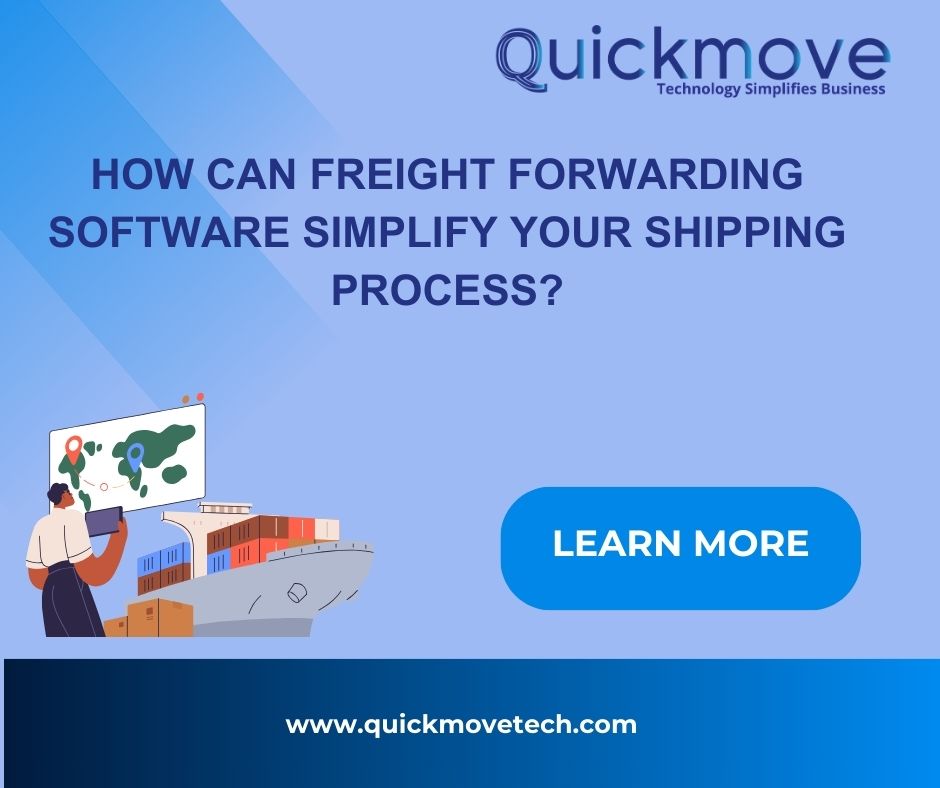In the intricate world of global logistics, managing the shipping process efficiently is a critical task that can significantly impact a company’s bottom line. Freight forwarding, involving the coordination of shipments from manufacturers to final destinations, is often fraught with challenges such as complex documentation, multi-party communication, real-time tracking, and cost management. Fortunately, advancements in technology, particularly freight forwarding software, have revolutionized the way businesses handle their shipping processes. This blog will delve into how freight forwarding software can simplify your shipping process, driving efficiency, reducing costs, and ultimately enhancing customer satisfaction.
What is Freight Forwarding System Software?
Freight forwarding system software is a comprehensive solution designed to optimize and automate the various processes involved in the transportation of goods across international borders. It provides logistics companies and businesses with a centralized platform to manage, track, and analyze their shipments efficiently. This software integrates multiple functionalities, including shipment booking, document management, customs compliance, cargo tracking, and performance reporting.
Key Features of Freight Forwarding System Software:
- Automating Documentation and Compliance One of the most cumbersome aspects of freight forwarding is the extensive documentation required to move goods across borders. Documents such as bills of lading, commercial invoices, packing lists, and customs declarations are vital, but manually preparing them can be time- consuming and prone to errors. Freight forwarding software automates the generation and management of these documents, ensuring accuracy and compliance with international regulations.
The software often comes equipped with templates for all necessary documents, automatically populating them with data from your system. This automation not only reduces the risk of errors—such as incorrect entries or missing information—but also speeds up the documentation process, allowing shipments to proceed without unnecessary delays. Furthermore, many freight forwarding software solutions offer compliance checks, ensuring that all documentation meets the specific requirements of the countries involved in the shipment, thereby reducing the risk of fines or shipment holds. - Real-Time Tracking and Visibility In the modern logistics environment, real-time visibility into your shipments is essential. Delays, route changes, or other unforeseen issues can disrupt your supply chain, leading to dissatisfied customers and increased costs. Freight forwarding software provides comprehensive real-time tracking capabilities, allowing you to monitor the status of your shipments at every stage of the journey.
This software integrates with various tracking systems, including GPS and RFID, to provide accurate and up-to-date information on the location of your goods. Whether your shipment is on the road, at sea, or in the air, you can track its progress and receive alerts in case of delays or other issues. This level of visibility allows you to proactively manage potential disruptions, adjust schedules, and keep your customers informed, which is vital for maintaining trust and satisfaction. - Enhancing Communication and Collaboration Effective communication is a cornerstone of successful freight forwarding. The process typically involves multiple stakeholders, including manufacturers, carriers, customs brokers, and customers. Coordinating between these parties can be challenging, particularly when relying on traditional communication methods like email or phone calls.
Freight forwarding software centralizes communication, providing a single platform where all stakeholders can share information, updates, and documents. This reduces the risk of miscommunication and ensures that everyone is on the same page. For instance, carriers can update their status directly in the system, and customers can receive real-time notifications about their shipments, reducing the need for manual follow-ups. Additionally, many software solutions offer integrated chat or messaging features, further streamlining communication and collaboration. - Optimizing Inventory Management Inventory management is closely linked to the shipping process. Effective coordination between inventory and freight forwarding ensures that goods are shipped in accordance with demand, preventing overstocking or stockouts, both of which can be costly. Freight forwarding software often integrates seamlessly with inventory management systems, providing a holistic view of your supply chain.
With this integration, you can optimize your inventory levels by aligning them with your shipping schedules. The software can automatically trigger replenishment orders when inventory falls below a certain threshold, ensuring that you always have the right amount of stock on hand. This not only improves efficiency but also reduces storage costs and minimizes the risk of lost sales due to stockouts. - Cost Optimization and Analysis Shipping costs can vary significantly based on factors such as distance, mode of transport, carrier rates, and fuel prices. Managing these costs effectively is crucial for maintaining profitability. Freight forwarding software provides tools for cost optimization by analyzing different shipping options and suggesting the most cost-effective routes and carriers.
The software can compare rates from multiple carriers, taking into account factors like delivery time, reliability, and additional fees. It can also consider the total landed cost, including duties, taxes, and other charges, to ensure that you are making the most economical choice. By automating this analysis, the software saves time and reduces the likelihood of costly errors. Additionally, many solutions offer detailed reporting and analytics, allowing you to track your shipping expenses over time and identify areas where further savings can be achieved. - Streamlining Billing and Payments Freight forwarding involves complex billing processes, with multiple charges for services like transportation, customs clearance, warehousing, and insurance. Managing these invoices manually can lead to errors, disputes, and delays in payments. Freight forwarding software simplifies billing by automating the generation of invoices and ensuring that they are accurate and consistent with the services provided.
The software can also integrate with your accounting system, streamlining the payment process and providing visibility into your financials. This integration helps in managing cash flow, reducing the risk of payment delays, and improving your relationships with carriers and other service providers.
Conclusion:
In a world where efficiency and accuracy are paramount, freight forwarding software offers a powerful solution for simplifying the shipping process. By automating documentation, providing real-time tracking, enhancing communication, optimizing inventory management, and reducing costs, this software enables businesses to streamline their operations, reduce errors, and improve customer satisfaction. Whether you are a small business or a large enterprise, integrating freight forwarding software into your logistics operations can provide a significant competitive advantage, helping you stay ahead in today’s fast-paced global market.
Investing in the right freight forwarding software is not just about keeping up with technological trends; it’s about transforming the way you do business, enabling you to deliver faster, smarter, and more cost-effective shipping solutions to your customers.
 sales@quickmovetech.com
sales@quickmovetech.com Freight Forwarding Software
Freight Forwarding Software Moving/Removal Software
Moving/Removal Software Warehouse Management System
Warehouse Management System Transport Management System
Transport Management System Project Handling Software
Project Handling Software Virtual Storage and Last Mile Delivery
Virtual Storage and Last Mile Delivery Customer Service Portal
Customer Service Portal Move Survey Quote Pro
Move Survey Quote Pro Digital Logistics Inventory App
Digital Logistics Inventory App Events
Events

